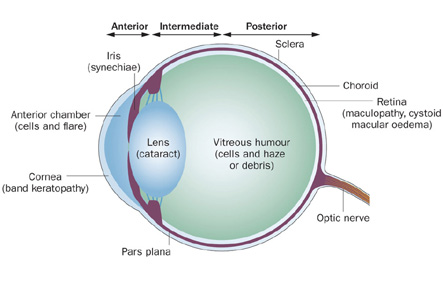Uveitis
Introduction
Uveitis is condition involving swelling and irritation of the uvea, the middle layer of the eye. The uvea provides most of the blood supply to the retina.
Causes
Uveitis can be caused by autoimmune disorders such as rheumatoid arthritis or ankylosing spondylitis, infection, or exposure to toxins. However, in many cases the cause is unknown.
Types or presentations of uveitis:
• Anterior uveitis:
This is the most common form of uveitis, which involves inflammation in the front part of the eye. It is often called as iritis as it usually only affects the iris (the colored part of the eye). The inflammation may be associated with autoimmune diseases, but it can also occur in healthy people. The disorder may affect only one eye. It is most common in young and middle-aged people.
Iran is now ranking first both in the region and in the Middle East and the Iranian ophthalmology science is among the world top majors

• Posterior uveitis:
Posterior uveitis involved the back part of the uvea which consists of the choroid, a layer of blood vessels and connective tissue in the middle part of the eye. This type of uveitis is called as choroiditis. If it also involves the retina, it is called as chorioretinitis. This condition developsin case if the patient had a body-wide (systemic) infection or has an autoimmune disease.
• Pars planitis:
Another form of uveitis is pars planitis. This inflammation affects the narrow bridging area (pars plana) between the colored part of the eye (iris) and the choroid. Pars planitis usually occurs in young men and is generally not associated with any other diseases. However, some researchers suggest that it may be linked to Crohn’s disease and multiple sclerosis.
Uveitis can be associated with any of the following:
1. AIDS
2. Ankylosing spondylitis
3. Behcet syndrome
4. CMV retinitis
5. Herpes zoster
6. Histoplasmosis
7. Eye injury
8. Kawasaki disease
9. Psoriasis
10. Reactive arthritis
11. Rheumatoid arthritis
12. Sarcoidosis
13. Syphilis
14. Toxoplasmosis
15. Tuberculosis
16. Ulcerative colitis
Symptoms:
Uveitis can affect one or both eyes. Symptoms usually include:
1. Blurring of vision
2. Floaters or dark spots in the vision
3. Pain in the eye
4. Redness of the eye
5. Sensitivity to light
Diagnosis:
A complete medical history is explored and thorough eye examination is performed. Laboratory tests may be ordered to rule out infection or an autoimmune disorder.
If the age of the patient of pars planitis is over 25 years, an MRI of their brain and spine should be performed to rule out multiple sclerosis.
Treatment
If the uveitis is caused by a body-wide or systemic infection, treatment may involve antibiotics or antiviral medications and powerful anti-inflammatory agents called as corticosteroids.
If uveitis is caused by an underlying condition, treatment is usually focused on that specific condition. The goal of treatment is to reduce the inflammation of eye.
Iritis:
This is usually mild condition. Treatment may involve:
1. Dark glasses
2. Dilating the pupil with eye drops to relieve pain
3. Steroid eye drops
Pars planitis:
This is often treated with steroid eye drops. For severe cases, other medicines such as oral steroid pills may be prescribed to suppress the immune system.
Posterior uveitis:
Treatment of this condition depends on the underlying cause but almost always includes steroids taken by mouth. Treatment of underlying infectious or autoimmune diseases such as syphilis, tuberculosis, AIDS, sarcoidosis, or Behcet syndrome is vitally important.
Treatment of uveitis may also include:
Appointment of the health care provider should be taken if there are above symptoms of uveitis.
A device can be implanted in the eye for patients of difficult-to-treat posterior uveitis. This device slowly releases corticosteroid medication into the eye for about 2 1/2 years.
Immunosuppressive or cytotoxic agents may be required in cases not responding well to corticosteroids or severe uveitis threatening the vision.
Surgery (Vitrectomy) — this surgery removes some of the jelly-like material in the eye (vitreous). This may be needed both for diagnosis and management of the uveitis. A small sample of the vitreous can help to identify a specific cause of eye inflammation, such as a virus, bacterium or lymphoma. The procedure can also involve removing the developing scar tissue in the vitreous.
Prognosis:
Uveitis is a relapsing disease. However, with proper treatment, most attacks of anterior uveitis go away in a few days to weeks.
Inflammation of posterior uveacan last from months to years and may cause permanent vision damage, even with treatment.
Possible Complications of uveitis:
1. Cataract
2. Glaucoma
3. Fluid within the retina
4. Retinal detachment
5. Loss of vision
When to Contact a Medical Professional
Appointment of the health care provider should be taken if there are above symptoms of uveitis. Eye pain or reduced vision is symptoms which require prompt medical attention